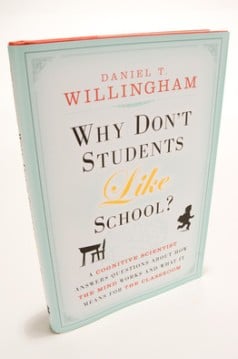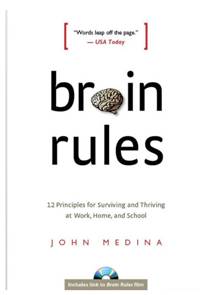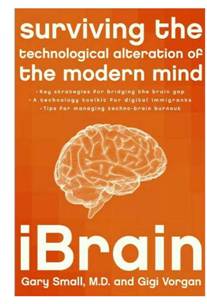
I just finished reading Dan Willingham’s (2009) book, Why Don’t Students Like School?: A Cognitive Scientist Answers Questions About How the Mind Works and What It Means for the Classroom. It is an excellent book full of practical suggestions to improve teaching, both online and in the classroom.
Dan Willingham is currently Professor of Psychology at the University of Virginia. His research focuses on the brain basis of learning and memory and the application of cognitive psychology to education. He writes the “Ask the Cognitive Scientist” column for American Educator magazine.
In this book, Willingham asks the question many of us have asked. After all, students are born as naturally curious creatures, so why are they turned off by education, even when they are paying to attend? Why can they remember the most trivial detail from a TV show or the words to a popular song, but not remember the answers on our tests? Willingham submits nine principles that he states explain this disconnect. Through these nine principles, he first attempts to explain how the minds of students work and then relate how to use that knowledge to improve teaching.
Principle 1: People are naturally curious, but we are not naturally good thinkers; unless the cognitive conditions are right, we will avoid thinking.
 Willingham states that our minds are not especially well-suited for thinking; thinking is slow, effortful and uncertain. So rather than thinking in most situations, we revert to relying on our memories – following courses of action we have taken previously. Paradoxically though, people tend to find successful thinking pleasurable – we like to solve problems, provided they are not too tough. John Medina (2008), in his book Brain Rules, stated that we are all powerful and natural explorers, and Willingham would agree. For problems to be solved, he suggests that the thinker needs adequate information from the environment, sufficient room in working memory, and the required facts and processes stored in long-term memory. In translating this to our classrooms, he suggests that we stage our instruction so that students have relevant problems to solve, respecting in the process their cognitive limits. Varying how these problems are presented to students and changing the pace can keep us from losing the attention of our students.
Willingham states that our minds are not especially well-suited for thinking; thinking is slow, effortful and uncertain. So rather than thinking in most situations, we revert to relying on our memories – following courses of action we have taken previously. Paradoxically though, people tend to find successful thinking pleasurable – we like to solve problems, provided they are not too tough. John Medina (2008), in his book Brain Rules, stated that we are all powerful and natural explorers, and Willingham would agree. For problems to be solved, he suggests that the thinker needs adequate information from the environment, sufficient room in working memory, and the required facts and processes stored in long-term memory. In translating this to our classrooms, he suggests that we stage our instruction so that students have relevant problems to solve, respecting in the process their cognitive limits. Varying how these problems are presented to students and changing the pace can keep us from losing the attention of our students.
Principle 2: Factual knowledge must precede skill.
Willingham states that there is no doubt that memorizing lists of dry facts is boring, but it is equally true that trying to teach students to analyze or synthesize in the absence of factual knowledge is problematic. These skills require extensive factual knowledge. He quoted Einstein, who said “Imagination is more important than knowledge”…and then spends the chapter refuting Einstein. From his cognitive perspective, knowledge is more important in that it is the prerequisite for imagination. For Willingham, this implies that in every course reading is fundamental. We should ensure that a knowledge base is in place before requiring critical thinking. This does not mean that boring presentations are okay. One of Medina’s Brain Rules: We don’t pay attention to boring things. Willingham suggests that one solution is look for some of that knowledge base outside of class – meaningful and pointed assignments using TV and internet videos can provoke learning.
Principle 3: Memory is the residue of thought.
Humans cannot store everything that happens in memory. So the brain selectively stores memories. And if one has to think about something carefully, the brain reasons that it might have to think about it again in the future, so it is a memory that should be stored. Medina stated this in two of his rules – Repeat to Remember and Remember to Repeat. Willingham provides some interesting research on memory. The lesson appears to be that material to be learned must spend some time in working memory (they think about it), but equally important, students need to think about the meaning of the material. It does you little good to use a clever video as an attention getter if at the end of class, the students remember the video but not the material covered.
Principle 4: We understand new things in the context of things we already know, and most of what we know is concrete.
We want students to be able to apply our lessons in new contexts, but the challenge is that the mind does not like abstractions. The mind prefers the concrete. Cognitive research therefore suggests that understanding abstractions is really remembering in disguise. If students are given lots of examples of a concept, the chances improve that they will then see how to apply a concept to new situations. Many of us have experienced the students who parrot our words back to us…but appear to not really understand. They exhibit shallow knowledge of the material. Students with deep knowledge tend to understand not just the parts but the whole. Therefore, it helps students to not only provide examples but to also ask them to compare the similarities and differences between examples. Deep knowledge should be your goal, but Willingham also argues that we should be realistic about just how deep our students can get in our short time with them. At best, we are launching them on a voyage of discovery.
Principle 5: It is virtually impossible to become proficient at a mental task without extended practice.
In Outliers, Malcolm Gladwell (2008) stated that what Tiger Woods, Mozart, and Bill Gates had in common was ten thousand hours of practice. Willingham agrees that practice is crucial – it helps one gain competence, helps one improve, helps protect against forgetting, and helps in transfer to new situations.
Principle 6: Cognition early in training is fundamentally different from cognition late in training.
Willingham notes that experts did not start out thinking as experts; they thought as novices. From his point of view, students are ready to comprehend but not ready to create knowledge. We should therefore not necessarily place students in positions where they are expected to create new knowledge (unless our reason is to have them take the journey, not create the destination).
Principle 7: Students are more alike than different in how they think and learn.
There will probably be some push-back on this principle, but Willingham basically states that there really are not different learning styles. He argues that what we consider as styles are really differences in cognitive abilities. From his point of view, there is little substantive research that demonstrates the existence of multiple intelligences. So rather than focusing on differences in students, he suggests focusing on differences in content. Delivering the same content in multiple ways creates multiple examples and provides change, which adds interest. Medina might agree with Willingham. He suggested in Brain Rules that instructors should stimulate more of the senses – and that vision trumps all other senses.
Principle 8: People do differ in intelligence, but intelligence can be changed through sustained hard work.
Alvin Toffler (1970) in Future Shock noted that the illiterate of the twenty-first century would not be those who could not read and write, but rather those that could not learn, unlearn, and relearn. Willingham suggests that intelligence is not a fixed trait, but rather a malleable one that can be impacted through hard work. Labeling students as dumb or slow becomes self-fulfilling. He suggests rather that we focus on and praise effort and process, not ability. If we treat failure as a natural part of the learning process and encourage hard work, we create a more positive learning environment.
Principle 9: Teaching, like any complex cognitive skill, must be practiced to be improved.
 The previous eight principles apply equally to use as teachers. We therefore need to practice, reflect on our processes, and seek feedback to improve.
The previous eight principles apply equally to use as teachers. We therefore need to practice, reflect on our processes, and seek feedback to improve.
Willingham concludes by noting that cognitive science can help us improve education, but it is not the whole story. Classes are not just cognitive spaces but also emotional, social, and even motivational spaces. Small and Vorgan (2008) in their book iBrain suggested that due to a generation immersed in digital media, a new digital divide is developing where younger students are comfortable online but lack social skills, whereas their older teachers are social but need to hone their technical skills. Willingham would suggest that understanding cognition can help balance these conflicting concerns in the classroom.
His final thought bears repeating: “Education makes better minds, and knowledge of the mind can make better education.”
![Reblog this post [with Zemanta]](http://img.zemanta.com/reblog_e.png?x-id=7a13a126-4556-4aff-8ec2-31924b941b48)
Hi, this is agreat blog, thank you!
I agree with you that in this Brave New World we must adapt the way we see education.
Thanks for this great summary Britt. I’m going to share it with my students to help them understand why I’ve designed the 1st course unit as I have.
That’s great, Melissa! Thanks for the note!
What an interesting blog post and it comes just as I am preparing two lectures for tomorrow. The bit that I’m still mulling over is Principle 7 and the learning styles. I suppose I have always thought learning styles relate to how we think. I like the idea to include as many different kinds of learning experiences (sensory, kinesthetic, auditory etc…). If we as educators can make content accessible in many different ways surely that goes to help Principle 3 too? Of course, Differentiated Instruction is built on this very idea of offering multiple entries into knowledge.
Thanks for sharing your review!
Great post and it’s like a glove for our educational system!
If I have to write which principle is on top I will say No. 5. In the past semesters I could see that one of the main reason students don’t “like school” is because they don’t like practice so, they don’t do it.
This is one of my personal challenge: to motivate them for an extended practice.
Thanks for sharing, Britt!
Interesting blog Britt.
Have you read the book Curious? by psychologist/scientist Todd Kashdan?
-book out in May ’09
I mention the book in this blog –
http://digg.com/d312vAk
Are you on twitter?
http://twitter.com/MarjieKnudsen
Good summary. I agree with all the principles but feel that one important one is left out: people learn optimally in a psychologically safe environment with a social norm of always trying to learn more. When people are surrounded by peers they can trust and there are no penalties for trying and making errors, learning naturally flourishes.